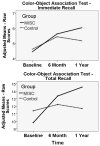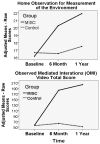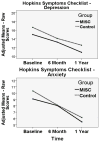A year-long caregiver training program to improve neurocognition in preschool Ugandan HIV-exposed children
- PMID: 23535340
- PMCID: PMC3655140
- DOI: 10.1097/DBP.0b013e318285fba9
A year-long caregiver training program to improve neurocognition in preschool Ugandan HIV-exposed children
Abstract
Objective: Mediational intervention for sensitizing caregivers (MISC) is a structured program enabling caregivers to enhance their child's cognitive and emotional development through daily interactions. The principal aim was to evaluate if a year-long MISC caregiver training program produced greater improvement in child cognitive and emotional development compared with a control program.
Methods: One hundred and nineteen uninfected HIV-exposed preschool children and their caregivers were randomly assigned to 1 of 2 treatment arms: biweekly MISC training alternating between home and clinic for 1 year or a health and nutrition curriculum. All children were evaluated at baseline, 6 months, and 1 year with the Mullen Early Learning Scales, Color-Object Association Test for memory, and Achenbach Child Behavior Checklist for psychiatric symptoms. Caregivers were evaluated on the same schedule with the Hopkins Symptoms Checklist-25 for depression and anxiety.
Results: The treatment arms were compared using repeated-measures analysis of covariance with child age, gender, weight, socioeconomic status, caregiving quality, caregiver anxiety, and caregiver education as covariates. The MISC children had significantly greater gains compared to controls on the Mullen Receptive and Expressive Language development, and on the Mullen composite score of cognitive ability. Color-Object Association Test total memory for MISC children was marginally better than controls. No Achenbach Child Behavior Checklist differences between the groups were noted. Caldwell Home Observation for Measurement of the Environment scores and observed mediational interaction scores from videotapes measuring caregiving quality also improved significantly more for the MISC group.
Conclusions: The MISC enhanced cognitive performance, especially in language development. These benefits were possibly mediated by improved caregiving and positive emotional benefit to the caregiver.
Conflict of interest statement
Figures




Similar articles
-
Randomized controlled trial of caregiver training for HIV-infected child neurodevelopment and caregiver well being.AIDS. 2017 Aug 24;31(13):1877-1883. doi: 10.1097/QAD.0000000000001563. AIDS. 2017. PMID: 28609401 Free PMC article. Clinical Trial.
-
A year-long caregiver training program improves cognition in preschool Ugandan children with human immunodeficiency virus.J Pediatr. 2013 Nov;163(5):1409-16.e1-5. doi: 10.1016/j.jpeds.2013.06.055. Epub 2013 Aug 16. J Pediatr. 2013. PMID: 23958115 Free PMC article. Clinical Trial.
-
Effect of Caregiver Training on the Neurodevelopment of HIV-Exposed Uninfected Children and Caregiver Mental Health: A Ugandan Cluster-Randomized Controlled Trial.J Dev Behav Pediatr. 2017 Nov/Dec;38(9):753-764. doi: 10.1097/DBP.0000000000000510. J Dev Behav Pediatr. 2017. PMID: 28991146 Free PMC article. Clinical Trial.
-
Attention Test Improvements from a Cluster Randomized Controlled Trial of Caregiver Training for HIV-Exposed/Uninfected Ugandan Preschool Children.J Pediatr. 2021 Aug;235:226-232. doi: 10.1016/j.jpeds.2021.03.064. Epub 2021 Apr 2. J Pediatr. 2021. PMID: 33819464 Free PMC article. Clinical Trial.
-
Association of caregiver quality of care with neurocognitive outcomes in HIV-affected children aged 2-5 years in Uganda.AIDS Care. 2016;28 Suppl 1(sup1):76-83. doi: 10.1080/09540121.2016.1146215. Epub 2016 Feb 17. AIDS Care. 2016. PMID: 26888568 Free PMC article.
Cited by
-
Interventions for developmental delays in children born to HIV-infected mothers: a systematic review.AIDS Care. 2019 Mar;31(3):275-282. doi: 10.1080/09540121.2018.1533629. Epub 2018 Oct 16. AIDS Care. 2019. PMID: 30324801 Free PMC article.
-
Psychometric properties of the Observing Mediational Interactions (OMI) coding system during mother-adolescent conflict discussions.Scand J Child Adolesc Psychiatr Psychol. 2023 Aug 17;11(1):95-107. doi: 10.2478/sjcapp-2023-0010. eCollection 2023 Jan. Scand J Child Adolesc Psychiatr Psychol. 2023. PMID: 37601624 Free PMC article.
-
Explaining antiretroviral therapy adherence success among HIV-infected children in rural Uganda: a qualitative study.AIDS Behav. 2015 Apr;19(4):584-93. doi: 10.1007/s10461-014-0924-7. AIDS Behav. 2015. PMID: 25323679 Free PMC article.
-
Randomized controlled trial of caregiver training for HIV-infected child neurodevelopment and caregiver well being.AIDS. 2017 Aug 24;31(13):1877-1883. doi: 10.1097/QAD.0000000000001563. AIDS. 2017. PMID: 28609401 Free PMC article. Clinical Trial.
-
Correlates of maternal depression, anxiety and functioning across an urban-rural gradient in northern Ecuador.Glob Public Health. 2024 Jan;19(1):2291697. doi: 10.1080/17441692.2023.2291697. Epub 2023 Dec 12. Glob Public Health. 2024. PMID: 38084739 Free PMC article.
References
-
- UNAIDS. UNAIDS Report on the global AIDS epidemic/2010: Joint United Nations Programmes on HIV/AIDS. 2010.
-
- Ronald AR, Sande MA. HIV/AIDS care in Africa today. Clin Infect Dis. 2005;40(7):1045–1048. - PubMed
-
- Bose S. ProQuest Information & Learning, Jul 1997 AAM9719709. 58. 1997. An examination of adaptive functioning in HIV infected children: Exploring the relationships with HIV disease, neurocognitive functioning, and psychosocial characteristics; p. 409. Dissertation Abstracts International: Section B: The Sciences and Engineering.
-
- Caruso N. Refuge from the Lord’s Resistance Army in Uganda: a report from a Medecins Sans Frontieres team leader. Emerg Med Australas. 2006;18(3):295–298. - PubMed
-
- Fabiani M, Nattabi B, Opio AA, Musinguzi J, Biryahwaho B, Ayella EO, et al. A high prevalence of HIV-1 infection among pregnant women living in a rural district of north Uganda severely affected by civil strife. Trans R Soc Trop Med Hyg. 2006;100(6):586–593. - PubMed
Publication types
MeSH terms
Grants and funding
LinkOut - more resources
Full Text Sources
Other Literature Sources
Medical

